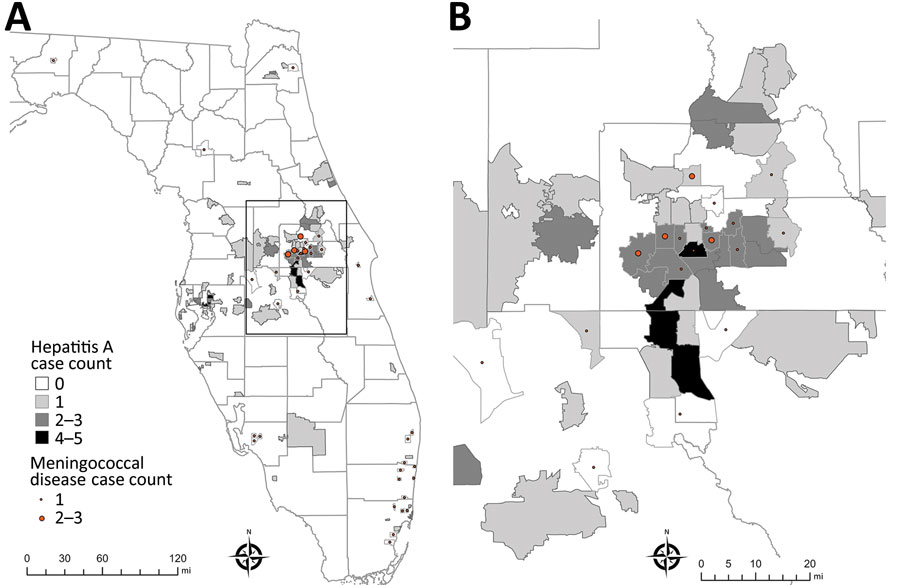Concurrent Outbreaks of Hepatitis A, Invasive Meningococcal Disease, and Mpox, Florida, USA, 2021–2022
Timothy J. Doyle

, Megan Gumke, Danielle Stanek, Joshua Moore, Brian Buck, Timothy Locksmith, Kelly Tomson, Sarah Schmedes, George Churchwell, Shan Justin Hubsmith, Baskar Krishnamoorthy, Karalee Poschman, Brandi Danforth, Daniel Chacreton, and
the outbreak investigation team1
Author affiliations: Florida Department of Health, Tallahassee, Florida, USA (T.J. Doyle, M. Gumke, D. Stanek, J. Moore, B. Buck, T. Locksmith, K. Thomson, S. Schmedes, G. Churchwell, S.J. Hubsmith, B. Krishnamoorthy, K. Poschman, B. Danforth, D. Chacreton); Centers for Disease Control and Prevention, Atlanta, Georgia, USA (T.J. Doyle, K. Poschman)
Main Article
Figure 2

Figure 2. Spatial distribution of outbreak-associated cases of hepatitis A and invasive meningococcal disease in an investigation of concurrent outbreaks of hepatitis A, invasive meningococcal disease, and mpox, Florida, USA, 2021–2022. A) Locations of cases by postal (ZIP) code of patient residence; B) detail of box from central Florida in panel A, in which >1 case of each disease were reported in the same postal code. Outside the area represented in that panel, no cases of both diseases were identified in the same postal code. Invasive meningococcal disease cases were georeferenced by postal code centroid. Small polygons are outlines of postal code areas. Light gray lines indicat county borders; dark gray lines indicate postal areas where instances were identified.
Main Article
Page created: February 06, 2024
Page updated: March 18, 2024
Page reviewed: March 18, 2024
The conclusions, findings, and opinions expressed by authors contributing to this journal do not necessarily reflect the official position of the U.S. Department of Health and Human Services, the Public Health Service, the Centers for Disease Control and Prevention, or the authors' affiliated institutions. Use of trade names is for identification only and does not imply endorsement by any of the groups named above.
